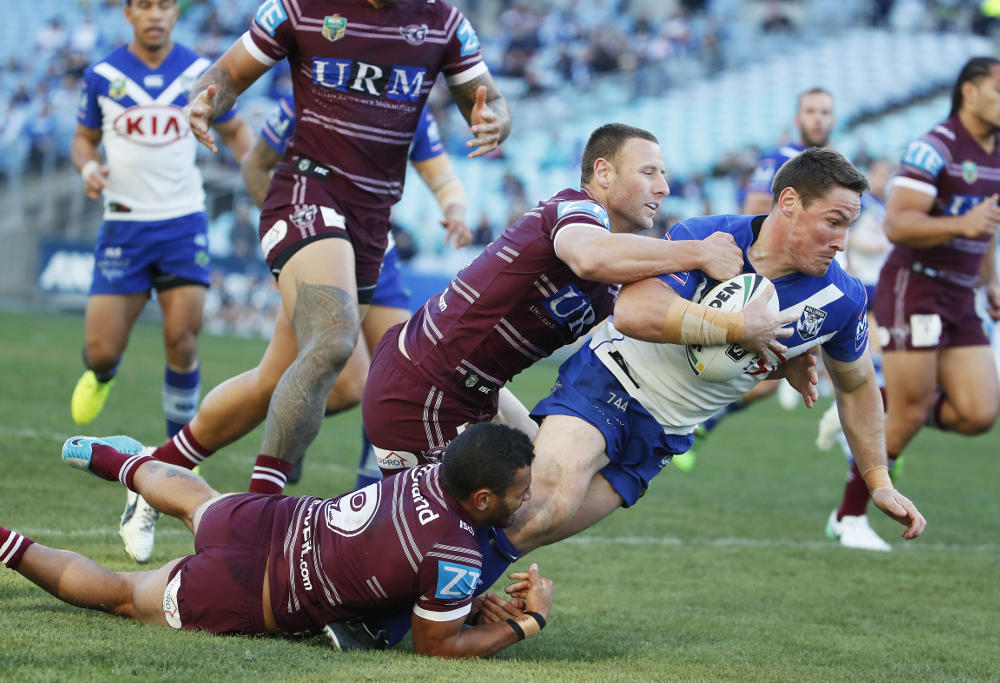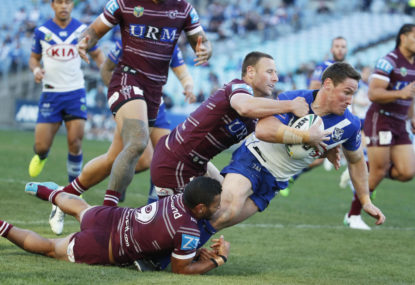I am consistently baffled by the modern game and one feature that pervades every match played.
Somewhere along the line, defenders got something in their head. They were probably encouraged and instructed to do it by their coaches.
In time they mastered it and have used it impressively over the last thirty odd years. It’s not a complex thing, just a simple tactic which has clear and negative ramifications on the entertainment value of the game.
Its implementation led to scrappy rucks, fifty-fifty decisions around ball control and also played a role in the development of the most modern blight on the game: the wrestle.
Attacking teams were forced to counter and the footless play the ball became the norm, as players attempted to increase the speed of the ruck to combat the one simple defensive technique that was the kernel of much of the nonsense we see today.
What was the idea they stumbled upon? Put simply, defenders became convinced that as a consequence of making a tackle, they were given some sort of divine right to be the marker in the subsequent play-the-ball.
You might stop and reflect on that for a second. It is the source of the inane and finicky disaster, that we now call the ruck contest.
Growing up, I have vivid memories of defenders making tackles around the legs. Whether it was a classic Steve Mortimer covering effort or the great Steve Rogers mowing down an opposition centre, players often lived by the ‘can’t run without legs’ mantra.
Obviously the game has changed a great deal and wrapping up the ball is a key component in blunting attacking waves, however, it was what the players did after they made the low defensive play, that is more significant to this discussion.
Once the tackle was completed, they leapt to their feet and sprinted back to their position in the defensive line, as one or two other players stepped up to take the marker position.

(Photo by Matt King/Getty Images)
This was reinforced by the referees at different times throughout NSWRL and NRL history, as they shouted ‘roll away’ upon the completion of the tackle.
It meant ‘get off’, it was also a signal for the defender to ensure they weren’t in the ruck area causing a distraction to the dummy-half.
Of course, this is always an issue in our game today and a few crafty rakes have perfected the art of planting their feet firmly and feigning contact with defenders in the ruck area with intentionally misdirected passes. But I digress.
As the coaches analysed tape through the eighties and nineties, they realised the obvious. That being, if the tacklers were able to stay in the ruck area and take the marker positions, it provided the opportunity for the remainder of the defensive line to maintain a set and structured formation.
The pesky problem was, the defenders needed to get to marker, essentially ignoring any appeal to roll away. Always reluctant to ignore the instructions of referees, the players consulted their coaches, fitness trainers and shrewd ex-forwards and decided to approach things a little differently.
Rather than disobeying the man or woman with the whistle, a new method of tackling was introduced. The low scything tackle became rare and front on hit-and-stick defence was popularised.
The entire benefit of this method is to ensure that the tackler never loses control of the ruck and, in turn, rises to their feet, quite often in perfect position to become the marker.
However, there was another little hitch to the sneaky plan, that being, with multiple tacklers involved in a ruck, it wasn’t possible for two players to be in the correct spot and in the box seat to assume the marker position.
No problem, easily fixed. Gradually, over time, the coaches and defenders infiltrated the minds of the officials and the rules committee and added another aspect to the technique.
As defenders started returning to their feet, it became obvious to them that it was easier to do so via a ‘boost’ from the ball carrier.
Thus the, two hands in the back, slow push to elevate themselves become in vogue, as the ball carrier remained firmly entrenched in the soil beneath.
The brilliance of this technique then allows the tackler to ‘turtle’ and squirm their way around to the correct position, stand fully erect and ready to chase from marker.
Not rocket science, yet genius in itself.
The perceived right of a tackler to automatically become the marker should have been spotted and stamped out, potentially it isn’t too late to reverse the trend. However, penalties for incorrect markers are as rare as a Wayne Bennett smile right now.
Reason being, markers are generally in the correct front position, if anything, they are too far from the play-the-ball’ often sitting back half way between the ruck and the defensive line. That is another issue altogether. Being square is one thing, being front and square is another.
Rather than redress this blight on the game, the interpretation of officials has added further layers to the issue of the tacklers expectation to automatically become the marker. Now, as the ‘turtle’ technique begins, further complexity is added.
Firstly, the Jujitsu stylings of NRL teams encourages all defenders to ensure that any limb available to them must be used as annoyingly as possible, as they manoeuvre themselves to the marker position.
Whether it be a hand wrapped around the ball or an arm wedged in an awkward spot, heck, sometimes even a foot can be strategically used to create a comical, ‘look sir, I’m trying to get away from the tackle, but I can’t.’

Joshua Jackson (AAP Image/Daniel Munoz)
To top off the faisco that is the modern play the ball, when the defender has achieved their goal and arrives in their final destination, it is important that they stand just that little bit too close to the man attempting to play ball.
Just enough to ensure a stray knee or foot is there in case the attacker dare attempt to play the ball without adequate care.
The chain of events that occurs when players deem themselves ordained to take the marker position, merely because they are in the ruck area, has been the fundamental source of so much frustration and anger from a fan perspective and seen the entire dumb-show become more and more problematic.
While it continues to go unpunished, the absurd speed of the current play the ball will continue, as players roll the ball back, briskly towards the dummy half. As will milking penalties in the ruck area and the constant emphasis on the grapple, which, despite full disclosure, seems permitted to continue.
Much of this could be mended. Sure, it would take some strong action and a paradigm shift in thinking from the officials.
However, a wise man once said something about life not being as complicated as people make it out to be.
Could it perhaps be as simple as remembering two simple words? Roll away.































































































